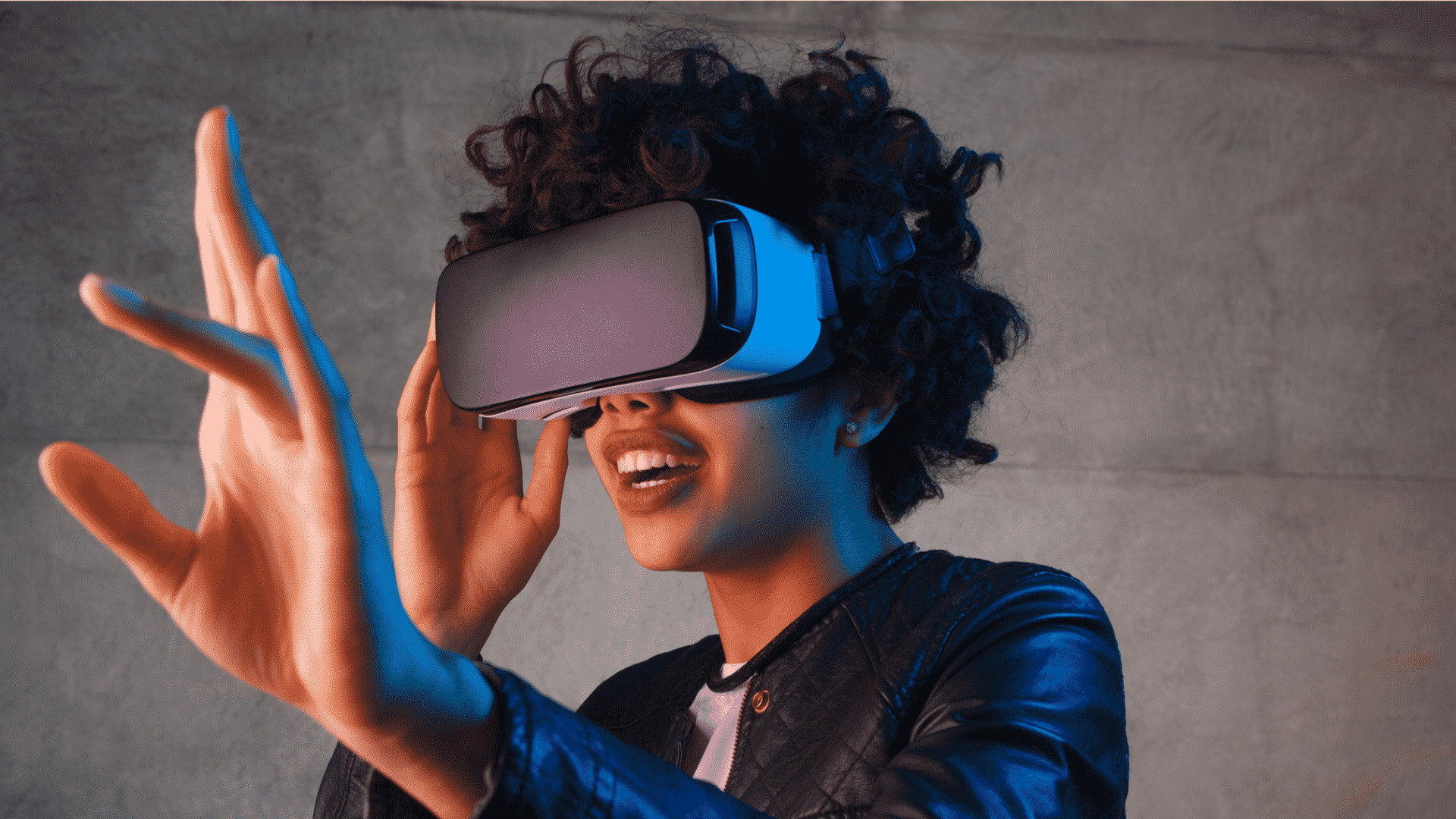MARKETING
Why we care about AR and VR: A guide for marketers

If there ever were a golden word in marketing, it’d be evolution. As consumers access more advanced technology, old marketing strategies fail to impress them. This is why modern marketers need to adapt to the constantly changing media and technology landscape to appeal to customers.
Two innovations marketers should stay abreast of are augmented and virtual reality devices. Although their marketing applications are still growing, both these tools are already being used in many ways. For example, AR is being used to let buyers see what furniture would look like in their homes.
Likewise, marketers should also ensure accessibility and interoperability with other more traditional experiences. Not to mention, as concepts like Web3 and the metaverse start to become more mainstream, these technologies will play a much larger role.
While the marketing applications of both are still emerging, these experiences are being tested in a host of ways that customers are beginning to have exposure to. For example, online shopping experiences are becoming more augmented through smartphone apps.
This article will discuss the ideas behind these two technologies, their differences, and the various outcomes that can emerge through using them. We’ll cover:
Estimated reading time: 11 minutes
What is augmented reality?
Augmented reality (AR) is a self-explanatory term— it is a tool that augments or enhances our perception of our physical surroundings. It helps bridge the gap between the digital and the physical world by overlaying digital elements in our immediate environment.
This data overlay can range from simple elements such as the lines displayed in a car’s rear-view camera while reversing to more complex product presentations for B2B clients.
With its significant interactive and engaging learning potential, it’s no surprise that the demand for AR has been exponentially increasing. As of 2021, AR’s market size was $6.12 billion, but it is expected to rise to a whopping $97.76 billion by 2028 at a CAGR of 48.6%.
What is virtual reality?
Virtual reality (VR) uses devices like VR headsets to create a completely immersive digital experience for users. Unlike AR, which combines digital elements with our real surroundings, VR offers a virtual replacement for our physical environment.
The idea of VR has been around for a pretty long time now. In fact, it debuted in the 1950s with Morton Heilig’s Sensorama and has been a staple of science fiction since the early 1930s. Modern VR, however, is still in its infancy.
That being said, the potential uses of VR are limitless. It has found applications in healthcare, entertainment, automobiles, education, and many other industries (we’ll get into specific cases later). The VR market is expected to reach $84.09 billion in 2028 at a CAGR of 44.8%.
The differences between AR and VR
Although there are some overlaps between AR and VR applications, these technologies serve different purposes. AR seeks to enhance and add to the way we perceive our surroundings, while VR attempts to replace it altogether. However, it is important to note that AR and VR are not competitors; they complement one another.
It might be more cost-effective to use AR for some purposes than VR since the former does not require any additional devices or headsets and can often be operated through a regular smartphone.

Examples of AR and VR
Both AR and VR find applications across many fields. This section will highlight some of their use cases across industries.
Augmented reality
AR in retail. Augmented reality tools can be used to recreate a 3D model of the item that customers wish to purchase. This 3D image can then be inspected in detail to provide customers with a better insight into the product.
Harley-Davidson is already leveraging augmented reality technology to enhance its customer experience. They have developed an AR demo offered in-store that lets users create photorealistic versions of vintage motorcycles. This app was created by Theia Interactive and is powered by Unreal Engine. Customers can zoom into the individual parts of the bike to look at a 3D-rendered model of them in a real-world environment.
AR in architecture and design. Architecture and design experts are using augmented reality tools in various stages of the production and development process. Apps like ARki can help non-architects understand the dimensions and layout of a building in the project planning phase by rendering a 3D model of the space.
AR apps like Fologram improve real-time collaboration between on-site project managers and construction experts by enabling virtual meetings. Fologram can also act as a replacement for blueprints on construction sites by displaying the underground layout of the area, including pipelines and electrical wirings in 3D.


AR in tourism. Augmented reality also holds a lot in store for the travel industry. It allows tourists to enhance their experience and perception of their surroundings by providing extra information about the place by simply scanning where the person is.
Apps like City Guide Tour are already making this dream come true. The app uses object recognition to provide information about popular attractions like museums, historical sites, and galleries. And all of this without the hassle of hiring a tour guide or looking everything up online.
AR also allows travel agents to immerse their clients in the location they want to visit. Potential tourists can take a walk through the streets of Paris and see what cafés they might want to visit or even compare it to the sunny beaches of Ibiza to decide where to go for their next vacation.
Virtual Reality
VR in the automobile industry. Virtual reality devices enter the automobile market at two junctions— at the planning stage of the vehicle and when the customer is purchasing it. In both situations, the parties involved benefit from the ability to visualize the product up close without having the car with them physically.
While companies like Jaguar have been using VR to create prototypes of cars for over a decade, Ford has also recently revamped their design process to trade in 2D drawings for 3D VR models. This helps manufacturers cut down on the overhead costs as well as the time taken to design a car.
Other automobile giants like Audi and Volkswagen have gone the Harley-Davidson way by allowing their potential customers to virtually sit inside the car they want to buy.
VR in psychology and mental health. As the emphasis on mental health grows, so do the tools that doctors have at their disposal. VR has emerged as a method for treating post-traumatic stress. People enter a re-enactment of the traumatic incident through a VR device to attempt to reconcile with the memory and start the healing process.
Similarly, VR can be used to treat other mental health disorders like anxiety and depression. It allows patients to confront their issues in a virtual environment without having to come in contact with the things they fear.
UW-School of Medicine and Public Health is already researching the potential of VR to treat teenage mental health disorders. The study involves getting participants to play a video game that allows them to control their breathing patterns. These researchers then use the data to identify children who are most in need of care.
VR in the sports industry. Many athletes are now using VR to enhance their performances on the field. VR is mainly used as a training aid in sports like golf, athletics, football, and cycling. It can be used to gauge the technique and overall performance of an athlete to help them improve their game.
NFL and college football teams are already integrating VR into their regular training schedules. It helps coaches and players recreate scenarios virtually to learn from previous instances. Additionally, even NASCAR drivers and professional soccer teams are using VR to retrace their mistakes in games.
VR can also be used to design better and more efficient equipment for sports. By using the technology to study stress patterns and durability of sporting equipment, companies can improve their products to better suit the athletes’ needs.
There are many tools available to you online that can be used to develop AR and VR-based applications. However, you need to consider the kind of product you wish to market to decide which software you should use.
For example, your choice will vary depending on whether you want to develop marker-based apps or location-based apps, etc. So, you must choose the correct AR/VR software development kit (SDK) for your needs.
Here are some SDKs that may be useful to your brand.
Vuforia. Vuforia is one of the highest-rated AR SDKs that frequently feature on lists of the best SDKs on the market. There are several products under Vuforia, including Vuforia Engine, Studio, and Chalk.
The added advantage of this SDK is that it allows the creation of both marker-based and markerless augmented reality applications. Marker-based apps are those which need to scan a physical marker like a barcode or a tag to trigger an AR experience.
Wikitude. Wikitude is an SDK that can be used to develop location-centric AR experiences. It allows users to integrate geolocation and cloud recognition software into the app. Wikitude allows 3D location, image recognition, and tracking. It also enables video overlay and can be used on smart glasses.
Apple ARKit. Apple’s ARKit was introduced back in June 2017, along with the launch of iOS 11. Since it has been tailor-made for Apple devices, it can be used to create apps for iPhones and iPads as long as they have an A9 processor or better.
It is an extremely versatile tool that allows developers to create applications that allow for 2D image detection and tracking, recognition and placement of 3D objects, facial tracking, and detecting planes.
ARKit’s software uses a camera sensor and other auxiliary data to analyze user surroundings for motion tracking. It is also easy to understand as Apple releases updated tutorials for every new iOS update.
Unity 3D. Unity 3D is a tool used to create VR environments accessible to professionals and amateurs alike. Its popularity and intuitive display make it easy to learn, and its vast array of 2D and 3D assets saves time and effort in creating new characters and landscapes.
Since Unity has a large user base, most issues with the software can be resolved within the community itself. It is also compatible with many devices like Oculus Quest headsets, VR/Vive, Playstation VR, Gear VR, etc., and operating software like Windows, Android, and Mac OS, among many others.
Unreal Engine 4. Unreal Engine is the preferred SDK for most professionals to build games and VR simulations. The software ensures high-quality graphics with advanced and realistic features. It also has a reliable store of assets that includes animations, plugins, live training, and blueprints that you can access to build your VR environment.
Despite its highly advanced features, Unreal Engine is supported on several platforms such as Windows PC, Mac OS X, iOS, Android, Linux, and HTML5. It is also compatible with Head-Mounted Devices like Oculus Rift, HTC Vive, Gear VR, and Google VR.
How AR and VR can help marketers succeed at their jobs
AR and VR mark the future of the digital marketing industry. By virtually immersing your audience in the product you’re trying to sell, you can bring them closer to the product.
Grab customer attention
Using AR and VR tools will help you reach a large audience, collect information about them, and personalize your marketing strategy to their tastes. The novelty of AR and VR in marketing can also help raise interest in the product.
Improve product visualization
AR and VR can help potential customers visualize in 3D before buying it. This gives customers increased confidence in the product they are purchasing. In this way, marketers don’t have to physically reach their customers to give them an experience of the product.
Try before you buy
Marketers can also let users try on the products virtually before buying them. Warby Parker has already pioneered this technology by letting their customers check how different glass frames look on their faces using AR.
Augmented and virtual reality technologies hold great promise for many industries across the world. They allow users to be transported into a world where they can virtually interact with a product without having to spend any money on it. In other words, AR and VR are game-changers. These two innovations represent an almost unprecedented customer experience.
Resources for learning more about AR and VR
Do you want to learn more about VR, AR, and their marketing applications? We recommend the following resources:
- Getting the most out of AR and VR experiences: Digital and physical are becoming closely interwoven. Consumers steeped in online shopping are going to want digital experiences (and seamless discovery and checkout) in-store too.
- Marketers: The metaverse is coming: The metaverse and Web3 aren’t here yet, but it’s time to start thinking about the positive opportunities they might create as well as the negative risks.
- Become a metaverse marketing maven: Find out where you can get smart with online training on immersive media for marketing.
- Google AR and VR: Augmented reality (AR) and Virtual Reality (VR) bridge the digital and physical worlds. They allow you to take in information and content visually, in the same way you take in the world.


















You must be logged in to post a comment Login